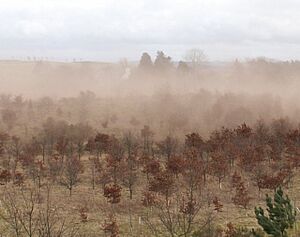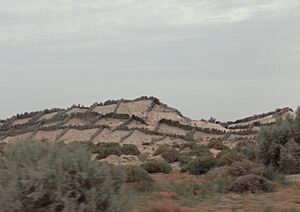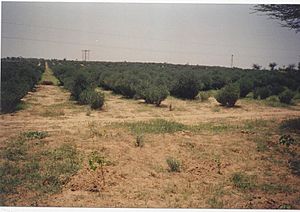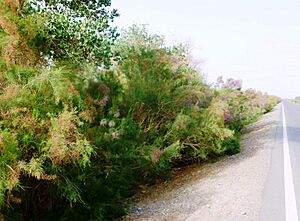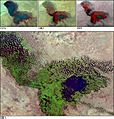Desertification facts for kids
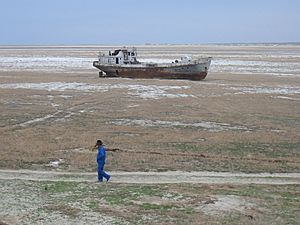
Desertification is when land turns into desert, or when deserts grow bigger. This happens when dry areas lose their plant life and healthy soil, becoming more like a desert. It's a big problem because desert areas around the world are getting larger.
People can help stop desertification in many ways. For example, we can make soil healthier, turn deserts green, manage how animals graze, and plant more trees. All these actions can help reverse the damage.
Contents
How Desertification Happens
Desertification usually starts at the edges of existing deserts. Many things can cause it:
- Climate change: Natural changes in weather patterns can make areas drier.
- Too many people: When more people live in an area, they need more resources, which can put stress on the land.
- Overgrazing: Too many animals eating plants in one area can destroy the plant cover.
- Cutting down trees: When forests are removed (deforestation), the soil is left unprotected.
- Drought: Long periods without rain make land very dry and fragile.
- Bad irrigation: Using water incorrectly for farming can damage the soil.
Effects of Desertification
Sand and Dust Storms

When land becomes desert, there's more loose sand and dust. The wind can pick this up, causing huge dust storms. These storms have become more common and stronger in places like the Middle East. This is because less rain means drier soil and fewer plants to hold the soil in place.
Dust storms can cause health problems like breathing issues and skin irritation. They can also pollute water, make clean energy efforts harder, and stop transportation. Dust in the air can even affect the climate by blocking sunlight and changing how clouds form, leading to less rain.
Not Enough Food
Desertification threatens the world's food supply. As the number of people grows, we need more food. However, desertification reduces the amount of good land for farming. About 44% of farmland is in dry areas, providing 60% of the world's food. If we keep losing farmland, there won't be enough food for everyone. This can also lead to conflicts over land, like those seen in parts of Africa.
More Poverty
Most people living in drylands are in developing countries, where they often face tough economic and social conditions. Desertification makes this worse because it reduces how much food and resources the land can produce. This makes it harder for people to earn a living.
When rural land can no longer support people, many move to cities, especially in Africa. This can lead to unemployment and crowded areas. The number of people forced to move because of environmental changes is growing every year. This creates a big challenge for neighboring countries that might not be able to support so many new people.
For example, in Mongolia, much of the land is dry. This causes many herders to move to cities for work. Those who stay must be very careful with their grazing animals to protect the land. When farming becomes impossible due to desertification, it hurts local economies and increases poverty.
Many groups, like the United Nations, are working to fight desertification and help restore damaged lands.
Stopping Desertification
There are many ways to slow down or even reverse desertification. Sometimes, the solutions are simple and just need people to work together. One challenge is that it can be expensive for farmers to switch to more sustainable methods, even if these methods are good for the environment and society. Also, sometimes there isn't enough political support or money for projects to restore land.
Desertification is a big threat to biodiversity, which is the variety of life on Earth. Many countries are creating plans to protect endangered plants and animals from its effects.
Making Soil Healthier
One way to fight desertification is to improve the quality of the soil. This involves two main things: getting water to the soil and making the soil stable and fertile.
To stabilize soil, people use shelter belts or windbreaks. These are rows of trees and bushes that reduce wind erosion and stop water from evaporating too quickly. They have been very helpful in dry areas of Africa since the 1980s.
Some soils, like clay, can become very hard without water. Techniques like zaï (digging small pits) or tillage (turning over the soil) can help prepare the ground for planting.
Another helpful method is contour trenching. This means digging long, shallow trenches along the natural curves of the land. These trenches stop water from flowing away and causing erosion. Stone walls are often placed around the trenches to keep them open.
To make soil fertile again, plants are often used. Leguminous plants (like beans) are great because they take nitrogen from the air and put it into the soil. Other helpful plants include succulents (like prickly pear cactus) and food crops like grains, barley, and dates. Sand fences can also be used to control sand movement.
Farmers can also use nitrogen-rich fertilizers to improve soil. However, these can be expensive for small farms. Some countries offer help to farmers to make these fertilizers more affordable.
Scientists are also studying how fungi called mycorrhiza can help trees in dry areas. These fungi attach to tree roots, helping the trees absorb more nutrients from the soil. There's also research into using engineered soil microbes to protect drylands.
Turning Deserts Green
There are different ways to make deserts green, depending on the type of desert. For example, salt flats in the Rub' al Khali desert in Saudi Arabia could be made fertile using seawater, without needing fresh water or much energy.
Farmer-managed natural regeneration (FMNR) is a successful technique for regrowing plants in damaged areas. Since 1980, this simple and cheap method has helped farmers in Niger regrow about 30,000 square kilometers of land. It involves letting native trees sprout and then carefully pruning them. The pruned branches can be used to cover fields, which helps the soil hold water and reduces evaporation. Well-spaced trees can also increase crop yields.
Better Grazing Management
Healthy grasslands can store carbon from the air. When animals graze, they eat the grass and can prevent it from growing well if they stay in one spot too long. A method to restore grasslands involves using fences to create many small areas. Herds are moved from one small area to another every day or two. This copies how wild animals graze and allows the grass to grow back fully. Experts believe that using this method on the world's grasslands could help remove a lot of CO2 from the atmosphere.
Planting Trees
Planting trees, known as reforestation (planting trees where they used to be) and afforestation (planting trees where there were none), helps fight desertification at its root. Environmental groups work in areas where cutting down trees and desertification cause extreme poverty. They teach local people about the dangers of deforestation and sometimes hire them to grow young trees. These trees are then planted in deforested areas during the rainy season.
The Food and Agriculture Organization of the United Nations (FAO) has launched initiatives to share knowledge and experience on restoring drylands.
The "Green Wall of China" is a famous example of fighting desertification. This huge project, started in the late 1970s, involves planting billions of trees to stop the desert from spreading. It's expected to finish in 2055. Chinese reports say that nearly 66 billion trees have been planted, reducing desert land by about 1,980 square kilometers each year. The number of sandstorms in China has also dropped by 20% because of this green wall. Because of China's success, there are now plans for a similar "wall" along the edge of the Sahara Desert in Africa.
In 2007, the African Union started the Great Green Wall of Africa project. This wall of trees will be 8,000 kilometers wide, stretching across the entire continent. It has received billions of dollars in support. So far, it has restored 36 million hectares of land, and the goal is to restore 100 million hectares by 2030. This project has also created many jobs in the participating countries.
Interesting Facts About Desertification
- The United Nations predicts that in the next 10 years, 50 million people in dry areas will have to move because of desertification.
- About 2 billion people live in and depend on dryland climates.
- Poor nutrition and a lack of clean water are common problems caused by desertification.
- The Great Green Wall is a plan to plant a wall of trees at the southern edge of the Sahara Desert to fight desertification. As of 2023, about 15% of the project is finished.
Images for kids
-
Lake Chad in a 2001 satellite image, with the actual lake in blue. The lake lost more than 90% of its surface area between 1987 and 2005.
-
Sun, moon, and large telescopes above Chile's Atacama Desert.
-
Sahel region of Mali.
See also
 In Spanish: Desertificación para niños
In Spanish: Desertificación para niños


